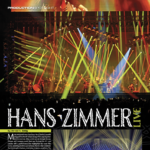
Having started performing at an early age, Janet Jackson has now been performing for 50 years and hasn’t missed a step. Again, hitting all the right notes, Together Again, Jackson’s 10th concert tour began on April 14, 2023, and wraps on June 21, 2023, in Seattle. The show works in five acts, each representing a different period of her musical journey. Having worked with Jackson for the past two and half years, Eric Wade, Principal of Crossfade Design served as Production Designer as well as Tour Director. Wade’s team included his sons, Aaron as Associate Production Designer, and Brandon, Lighting Director. Keeping with the family vibe, Troy Eckerman was Associate Lighting Designer/Lead Lighting Programmer and he worked with his son Caleb who serves as a Lighting Programmer on the tour. As Jackson’s tour plays sold-out dates across the U.S., Wade and Eckerman took time to speak with PLSN about the design and production solutions supporting this dynamic artist’s tour.
Wade begins with the overall design and the aesthetic that he and Jackson felt was right for this tour. “This tour started out a little differently, because I didn’t just design it,” says Wade. “Our company has taken on a whole new philosophy for helping people get tours on the road. We do everything from the start. I worked with management, worked out budgets, I put the entire tour together. We got bids from all the vendors. Unusually, it worked a little backwards than a production design would normally go. Normally I have somebody call me, and they give me a number and go, ‘This is what we need to be around this ballpark, and design something for us.’ Here, I created the numbers based on ticket sales, the venues, and what she was making, and then we designed something to fit that. It was a much different concept in the way we used to do things, but it worked out nicely.”
He went backwards from the amount of crew and trucks he wanted to take on the road, saying, “’Okay, let’s design something that’s going to fit this for them,’ and keep her in budget where her tour is profitable, she makes money, the fans get the best experience, and we can open up more seating,” explains Wade. “I worked with Live Nation to make sure that what we designed could be opened up as far as 270° if needed. We designed to keep sight lines clear. The concept for it, initially, she was looking at this massive set with a lot of things. Janet gets very involved and I spent multiple days on the phone with her going through things, talking about what she wanted, and then as well as Gil Duldulao, her Creative Director. He takes care of all the staging aspects and helped decide what the scenes needed to be, then we created the atmosphere they wanted.”
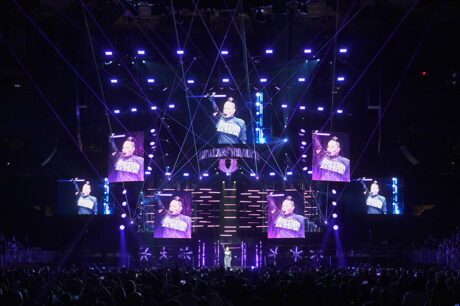
Building Out the Stage
In the design process, Wade moved them away from a massive stage to an open concept. “It turned out really nice because the whole stage is pretty much a flat open space with a circular riser in the middle for her,” he describes. “We did a ‘wet’ Marley floor because she loves a high-shine floor. She initially didn’t want to have a band. Then Randy Jackson, her brother, said that he wanted to bring in a band. So, the band been working with her, and for the show we did a hybrid of each idea. The show starts out where you don’t even know there’s a band up there because we completely hide them. We have them on 16’ x 8’ rolling risers in the back. Aaron and I called a ‘garage’ where we hide them behind low-res video. That low-res video is on automation so that later in the show, in a blackout transition, we slide those risers downstage, then the screen comes back down behind them. Now you’ve got a band in the picture. We came up with concepts like that for them, ways that we can have the best of both worlds. The design is very layered, very deep, with a lot of moving pieces. We’ve got about 20 Kinesys motors, so all the video screens are automated. Altogether—with the ‘halo,’ ‘sphere’ and two I-Mag screens—we have a total of 11 video screens.”
Working from the center out, the design gave Jackson a performance area consisting of a 15’ circular riser right in the middle of the stage because, “she likes having a riser in the middle,” states Wade. “Like I said, the stage floor is high-shine black, and the riser is topped with high-shine gray, with a black Plexi, high-shine fascia on the sides. I special ordered through PRG with [Project Manager] Jason Winfree, a two-meter video globe, which we don’t even reveal until the ballad section—the third act of the show. The globe flies in and out, and we created a halo around it. The halo is a 15’ circular truss, with video fascia all the way around it and it has the new Ayrton Perseo Beams all around the bottom of it. That circular truss flies in and out—separately around the globe. The halo can tilt, turn; it’s on Kinesys motors as well.”
The team really liked the Perseo Beams. “It was a very good selection,” says Wade. “It’s got 48 gobos; it’s bright; it’s LED; it does beams; and it floods out with gobos. It’s really impressive.” Aaron adds, “I would say it’s probably our most versatile light in the rig.”
In the third act ballad section of the show, the globe flies in and comes within a couple of inches from the floor. “When Janet starts to performs in front of the globe,” explains Wade, “we have a laser that comes down over the top of the globe, and she stands in front of it; we don’t even spotlight her. She’s just in the background of the globe with a downlight of red on her to begin with; just really modeled and it’s very theatrical. The whole show is very theatrical. We got away from a ‘concert vibe’ and lean more towards theatrics with her.
So, they started with these elements—the riser, globe, and halo, and built the show out from that point. “It turned out, at the end of the day, it’s probably one of the best-looking shows I’ve done since I did Usher in mid-2015,” comments Wade. “I’m very happy with this show. It’s funny how it all developed with her and Gil’s input and all of us going back and forth with it in multiple meetings. Aaron and I would sit and start making changes and think about what they wanted to do and give them ideas. We ended up with a small set in the back. It’s made of 12” truss. We’ve got four decks and we skinned them on the top and around the sides with a black spandex from Sew What?. We built a couple custom firemen’s poles so the dancers could slide down versus always going up the stairs. That’s really the only scenic piece in the back. They use it as a platform to dance on and she ends the show on top of it. The dancers are up there all the time, like climbing on a jungle gym. They’re all over it. Our office, Crossfade Design, did some props. We do a lot of custom metal fabrication, so we did custom, polished canes for her and the dancers.”
Stage Crew as Performers
They also created some simple dancer boxes for them to dance on and jump on and off. “Those dancer boxes with Marley on top that the carts bring in and out are very low tech,” notes Wade. “In today’s high-tech world, we’re just moving boxes on and off stage. We’re hand-moving the band risers, just rolling them with stagehands. It’s all very simple, but very theatrical at the same time. I told Janet we’d move things in and out with stagehands, because going to automation, mobilator, and all that is a big expense, as well as needing a lot of time, and more personnel. Instead we made the carpenters and stagehands all part of the show. We give the stagehands clothes where they look like they’re part of the show. She wanted them all dressed in black jumpsuits.”
The creative team rose to the challenge of creating many different looks over the course of the show. “That was a big thing,” says Wade. “Initially, she wanted a lot of things like inflatables and things to create different looks and give every act its own look. Between Gil and I, we sat down going through, ‘Alright, let’s make this act primarily this look, centered around this costume.’ The second act had 10 songs, and the whole section is black and white. Then we go into the colorful section where it’s tons of color, more like a dance and a rave, a party. Then we get into the end of the show, which is the Rhythm Nation part of the show, and we get more into your standard concert vibe. We go into a look that is full-on, full-blown concert.”
Automating the video screens afforded the creative team a variety of looks. “We did most of the looks by moving the screens down,” Wade continues. “The screens go up for their home position and hey come down to the floor; we do them at all different heights. We reveal the band with a low-res video screen, that we brought down and up. With all these different screens/positions and the motion of the globe and halo, let us create tons of different looks.”
In the black and white section, they brought down the main screen, which consists of ROE Visual 8mm LED panels. “We went with all ROE CB8, an 8mm product,” comments Wade. “You find everybody going, ‘I’ve got to have 3mm. It has to be 3mm!’ When you’re in Madison Square Garden, you’re not going to tell the difference between 3mm and 8mm screens from 60’ to 80’ away. The cost-savings were drastically different going with an 8mm product and the ROE CB8 is roadworthy and proven. With automation we raise the screens up and down and reveal the dancers. We basically are using the screens like you’d use drapes and linesets in a theater.”
At the top of the show, Wade and the creative team came up with a big reveal to kick things off right. Jackson wanted a slideshow of her 50 years of performing, so Wade brought in Video Editor, Jacob Bann to create an opening montage of her career. “Not many artists started performing when they were seven years old!” points out Wade. “For the reveal of the show, we have a V-pattern truss that we do a 50’ wide kabuki drop. We have a sniffer up top center, downstage of the halo. For her reveal, she’s behind the drape, prepared, and we drop the kabuki. We let it get about 15’ off the floor before we sniff it up. So, it looks like it’s just going to be a regular drape. Drop it, and then it just sucks up right above her. It’s a really nice opening show effect. We light it, and we’ve been doing all kinds of stuff during the intro video. It looks amazing.”
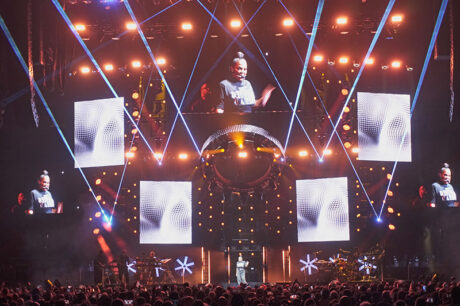
Key Equipment Choices
In addition to the Ayrton Perseo Beams, Wade went with a range of lighting and video equipment to realize his design. Key to his design was to rely on some “good old workhorses,” says Wade. “When Aaron and I sat down we decided to pick some specific instruments that we definitely wanted and build from there. We started with the new Ayrton gear—the Perseo Beam and Profile. The Perseo Profiles are all on the downstage truss; primarily all they do is zactrack. Brandon, my other son, and Aaron’s twin, is the Lighting Director on the show and is also the zactrack Designer/Programmer. At Crossfade we own a zactrack system and we’re using nothing but zactrack for the followspots on Janet. We have two FOH house spots primarily just as backup. We used GLP’s JDC1s for the big strobe and flash. I went with SGM G7s, which I wanted, but had not used before. PRG had about 32 of them available at the time. So, really it was Aaron and I going through and picking from what was available. We found gear that was affordable for us that we could put in the design that would be good workhorses, like the Robe MegaPointes. They were our only lamped fixtures that we used; we have Claypaky K20 B-EYEs in the system, which does a lot and does a good job. It’s bright. Janet is real big into sidelights, so we have GLP FR10 Bars on the sides. We use those along with MegaPointes that are alternating on the sides because we tried to keep everything clear and open. We also utilize a lot of fans with her; she loves fans. We have [Martin Jem] AF-1s on the side; we have about 18 fans all around. Then, we did utilize, because we knew we’d be going into sheds and I wanted to get something back in for the band, because they’re hidden behind the low-res video a lot, the GLP Force 120. That is a large 3’ diameter, variable speed fan with internal RGB LED lighting. We had three of those on each side. When they are off you don’t really see them; but light them up and it gives you an industrial look when we get to the Rhythm Nation section of the show that is great.”
On the set, Wade deployed GLP Bar 20s up and down the set. Since there was no center video screen, Jackson noticed that when the LED sphere and halo were in the down position, there was a big black hole that needed to be addressed somehow. “One thing that we started out with, that for sure was, she didn’t want the generic upstage wall of video,” explains Wade. “She said, ‘That’s what everybody does. Let’s do something different.’ There’s no center video anywhere, so we ended up making a Sceptron wall in the back. We used a lot of truss from PRG to create a bunch of ladders, each on a little 1/8-ton motor. They could be moved independently. We used a combination of Martin Sceptrons and TMBs little Mozarts, a small, square LED fixture on those ladders. I have one Elation Proteus Maximus on the whole show and it’s a great light that is super bright. It looks great. The first time we utilize it is when the globe is down. It’s placed on a ladder up center and we bring it on and throw it in a big gobo. It completely outlines the globe with beams of light coming all around it and then there she is. That light turned out to be an amazing light for her. Very dependable too. I mean, we’ve only got one back there, so if it doesn’t work, you lose the effect.
360 Services
Production Resource Group (PRG) provided full 360 equipment and services—Lighting, Video, Automation & Rigging, Scenic, and Audio—for the Jackson tour. It was a choice that Wade and the creative team were very happy with. “Initially I put this out to bid to just about everybody on the planet, because everybody wanted to bid on it, of course,” recalls Wade. “We ended up going full 360 with PRG, with Jason Winfree as my project manager. I’ve been working with him for probably 25 years, going from being an electrician, to being a programmer, to a LD for me to now being my project manager for PRG. The support has been nothing but spectacular. I’ve got so much history with a lot of the guys, who are old friends and when I need something from PRG, it’s there the next day.”
The many locations of PRG were something that Wade really valued. “One thing I do really love—that is hard to get around with other companies—is the fact that anywhere I’m at I can usually get support from PRG. They are all over. They’re not having to ship things; and shipping the way it is these days is very unreliable. We just wait until we get to a city where they’ve got a shop, and we pick up what we need. They’ve been outstanding. It’s the very first time I’ve ever used their scenic department. The sniffer is theirs; all the automation is theirs, the risers. They did all this stuff, and really knocked it out of the park. It’s been great.”
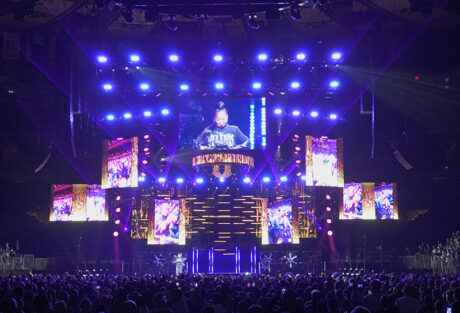
Media Servers and Control
Like the control, all the media servers were provided by Wade’s company, Crossfade Design. “We’re using the Mbox, Mbox Designer specifically,” he says. “Aaron and I custom built the racks for the tour, along with Sam Brown, another one of my guys, who is the Screens Director. We’re running the new Mac Pros. We worked closely with PRG’s Matt Corke, their support guy for Mbox, who helped us with beta software.”
Wade adds that “we have a lot of live inputs. Basically, we’re running that with all AJA routers and the two racks of Mboxes. We’re running everything 1080P; there’s no 4K anything because we don’t have one ginormous large screen, so everything is broken down in individual outputs. The media servers worked out fantastically.”
There’s a segment of the show, Wade notes, “where we’ve now partnered up with Apple, who provided us with a bunch of iPhone 14 Pro Maxes. We’re taking four Pro Maxes, in a small rig setup and broadcast data from the iPhones over 12G back to the video system. The dancers take these phones and use them on stage. They shoot her; we use them for the encore; the dancer go out into the audience, they run around all over the place to shoot the band, shoot the crew. Everybody’s on screens. It’s a really cool moment. Aaron had them flip the iPhone screen, where when it’s on the screen it looks like it’s your iPhone up on the video screens. These are all live inputs into the Mbox media servers.”
The consoles, also from Crossfade, are all MA Lighting grandMA3s. “We have three grandMA3s on the show and we run the entire show over sACN to be able to utilize zactrack wherever we wanted to use it. I must say too, the zactrack system, I’m blown away with. I put two sensors on every dancer; two sensors on Janet and we flip-flop with different costumes. We’re using 25 trackers, but what we’re using them for is flipping them in the costumes. So, they are sewed everything in,” Wade continues. “The zactrack system is phenomenal. Not using spotlights and calling a bunch of spots is pretty amazing.

Lasers and Special Effects
For the lasers used on the Janet Jackson tour, Wade worked with LaserWolf FX out of Oklahoma City. “LaserWolf is run by Hunter Owen,” says Wade. “We have 10 laser heads on the show and an operator, Michael Moore who’s an EDC guy. So, oddly enough, he’s never toured before. The touring industry was completely new to him. He does tons of those festivals and all that stuff, which turned out to be amazing because he’s used to running things on the fly. For the DJ section of the show everything’s run manually. There’s no timecode. It’s just songs and guys running songs. I like it to be different every night. It’s basically a punt section of the show. It certainly keeps all the operators from getting bored. It gives them those moments to just be creative and do their thing. Michael really excels with that; any given night you walk in and the lasers are different for that section. He’s always making new things and changing them. Yeah, LaserWolf did an excellent job. I couldn’t be more pleased with Hunter and LaserWolf FX.”
Family and Friends
On the lighting side, Wade brought in Troy Eckerman as an Associate Lighting Designer and Lead Lighting Programmer and Troy’s son, Caleb Eckerman, as Lighting Director and Keith Hoagland as Associate Lighting Designer & Lighting Programmer. “Troy helped me put all the lighting together and worked with all the guys to program it,” says Wade. “I even brought Keith in because I wanted different looks for different acts. So, to me, bringing in other guys that are Programmer/Designers to do these songs for me and help me with this tour, was amazing. I gave them the concepts, what I wanted, and they just ran with it. It turned out wonderfully because we have so many different looks in the show that way. The guys did an amazing job. Brandon is the Lighting Director and calls every cue in the show, including all the automation cues and stage moves. He’s doing all that at front of house. On the content side, Sam Brown, one of our Crossfade Design employees, is the Graphics Screens Director, who did all the content and ran it all; outputting from the Mboxes. He’s a great kid. My Video Director is Garry Odom, who’s been in the business for eons. I’ve done tons of work with Garry, who determines where things go on the screens, as well as mixes and cuts our show.”
Wade feels that he was successful in delivering a tour that suited Janet Jackson and her performance. Summing the tour up in a word, he says, “Theatrical. She wanted something theatrical, something that was clear and open for people to see. I think that at the end of the day we gave her what she was looking for, and then all we had to do was let her get onstage. To be honest, she doesn’t need bells and whistles because she’s Janet Jackson; she’s wonderful. Plus, her knowledge of the industry and the way everything works is unparalleled. I’ve worked with a ton of artists, and I’ve met very few that know so much about the industry. I mean, who wouldn’t after 50 years?”
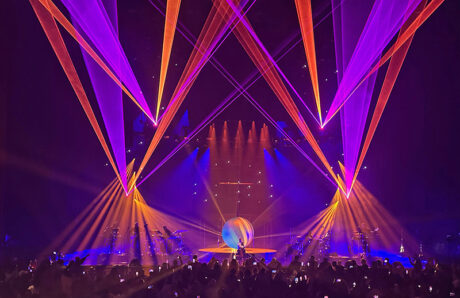
DIFFERENT PERSPECTIVES
Troy Eckerman has known and worked with Wade on numerous projects over the years and was happy to join him in programming for the Janet Jackson tour. “I think some of the things that we brought were a different perspective, as well as I had my son Caleb there, which is a young, fresh programmer mind,” says Eckerman. “It’s always good to get other ideas from other people. Basically, we came in and we tag-teamed the programming with Eric and our friend from Nashville, Keith Hoagland. When Eric found out I was available—I was supposed to be doing Tim McGraw and that fell through at the last minute—he asked me to join them. His take was ‘I don’t have to babysit you, I don’t have to micromanage, you can just handle it and you can do it.’ That’s the way I like to work anyway, if I have a choice. I think we all have different styles of how we program. They’re all good; they’re all different. I think that helped, because there was a difference. You could see some of the stuff that Keith and Eric programmed together, and then you could see some of the stuff that Caleb and I worked on together and programmed. It was nice having that variety. At first, I was a little skeptical about the idea, but then it turned out really good.”
With a deep resume of shows programmed, Eckerman still had to deal with the challenge of creating a variety of different looks over the course of the performance. “That’s always a problem with shows that have a lot of songs, because of course you want them all to look different,” Eckerman comments. “You don’t want to repeat anything if you can keep from it. Sometimes that’s hard to do, because you gravitate to the stuff that looks so fantastic and you sometimes want to use it again. Every now and then, we sneak things back in, but I think it was a good design system, because we had a lot of layers. We had a lot of types of lights. They were in different elevations and planes. We had vertical ladders with horizontal trusses. All that gave us a lot of really, really great looks. We didn’t have our hands tied quite so much, because we had so many different things that we could go and grab and use that were different. So, we tried to make it all different. The others did the ballad section, which was very low-key and intimate right around the video ball, which was totally different than all the big huge looks that Caleb and I made. OVer the whole show there really were a lot of different looks. Basically, it boiled down to we really had a good system to work with.”
Caleb Eckerman, following in his father’s footsteps, has been earning a good reputation as a programmer in his own right. In addition to Janet Jackson’s tour, he’s worked on a wide range of projects including touring with Tears for Fears, festivals, and a Texas mega-church. Troy was pleased to have the opportunity to work with Caleb on this Jackson tour. “He was excited to do this tour—it’s a big tour,” says Troy Eckerman. “He didn’t know who Janet Jackson was at first, he knew who Michael Jackson was. I told him this would be good, she is really good. He wanted to just go and do a lot on his own with me not saying much and I told him that I would give him every chance. If it didn’t look right, or I don’t like it, I’ll say something, and we would change it. There were a couple songs that I let him do on his own while I was dealing with video stuff. I just told him to keep programming. I went back to look at it, and I said, ‘Wow. I don’t know. A little busy, a little bit flashy. But, maybe not.’ I said ‘You know what? This is Janet Jackson. This is the kind of stuff they might like.’ You totally have to think about who you’re working for. Just because I don’t like it flashy and busy, that doesn’t mean that they don’t. I didn’t have him change it and we let it ride. They kept it. It even started growing on me, and really, that was one of the best songs we had. I told him a million times that he was doing a great job, and that he totally has a great eye for all this, as well as a great heart and passion for this work. I couldn’t be happier—as a dad—just like Eric is working with his sons.”
Production Team
- Creative Director: Gil Duldulao
- Tour Director / Tour Manager / Production Designer: Eric L Wade
- Production Manager: Daniel O’Neil
- Road Manager: Derek Wilson
- Stage Manager: Michael Hosp
- Assistant Tour Director: Toni Wade
- Production Coordinator: Karen Colvin
- Associate Production Designer: Aaron Wade
- Associate Lighting Designer & Lead Lighting Programmer: Troy Eckerman
- Associate Lighting Designer & Lighting Programmer: Keith Hoagland
- Lighting Director / zactrack Designer & Programmer: Brandon Wade
- Lighting Programmer: Caleb Eckerman
- Lighting Crew Chief: Robert Simoneaux
- Lighting Crew: Thomas Randy Foote, Ryan Textor, Mike Jackson, Ernest Guzman
- Video Director: Garry Odom
- Associate Video Director: Paul Ferreira
- Associate Media Designer / Graphic Screens Director: Sam Brown
- Video Editor: Jacob Bann
- Video Engineer: Samuel Foumberg
- Video Crew Chief: Johnny Martinez
- Camera Utility: Christian Medina
- Video Crew: Dana Jespersen, Koty Russell, Ben Hansen
- Laser Programmer/Operator: Michael Moore
- Head Rigger: Clayton Hutson
- Rigging Coordinator: Bill Rengstl
- Riggers: Kurt McLaughlin, Hannah Vittitow
- Automation Programmer/Operator: Andrew Rebmann
- Carpenters: Jacob Ream, Alex Romero, John Fickes
Vendors
- PRG (Lights/Video/Scenic/Audio) Project Manager Jason Winfree
- Crossfade Design LLC (FOH Control / Media Servers & zactrack)
- Earlybird Visual LLC
- LaserWolfFX
- 13MFG
Gear
Lighting
- 3 MA Lighting grandMA3 full-size Console
- 32 Ayrton Perseo Beam
- 20 Ayrton Perseo Profile S
- 26 Claypaky A.LEDA B-Eye K20
- 1 Elation Proteus Maximus
- 19 GLP impression FR10 Bar
- 20 GLP impression X4 Bar 20
- 33 GLP JDC1 Hybrid Strobe
- 6 GLP Force 120 LED Fan
- 36 Robe MegaPointe
- 21 SGM G7 Beast
- 130 TMB Solaris Mozart
- 112 Martin VDO Sceptron 10
- 1 zactrack Automated Follow-System
- 30 zactrack Automated Follow-System Tags
- 1 Depence Visualizer
Video
- 11 ROE Visual CB8 LED Screens
- 1 ROE Visual CB8 Halo
- 2 PRG MBox Server Racks
- 1 Lot VER Revolution FlexMesh 50
- 1 2m Video Sphere
Lasers
- 3 Lightspace 22W
- 4 Lightspace 25W IP65
- 4 KVANT Clubmax
